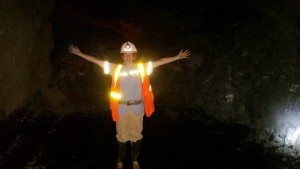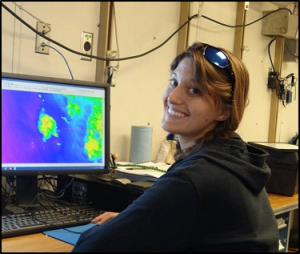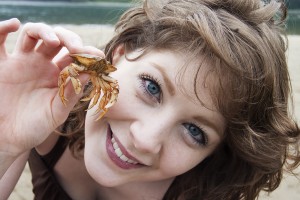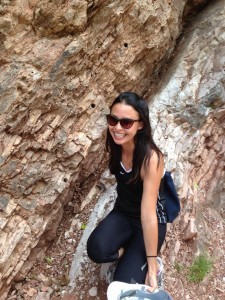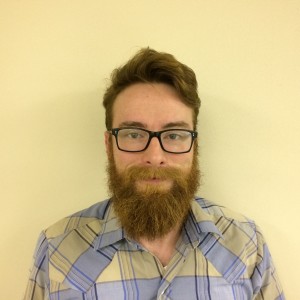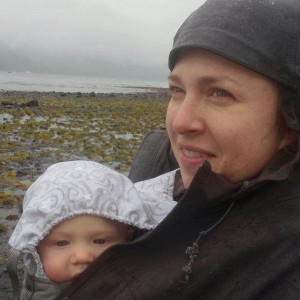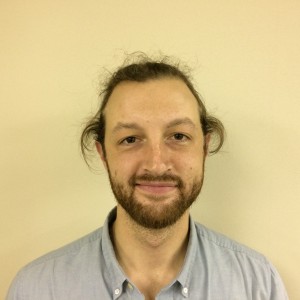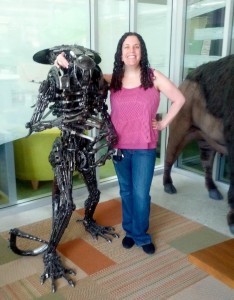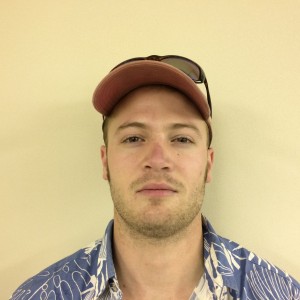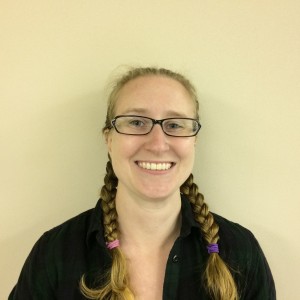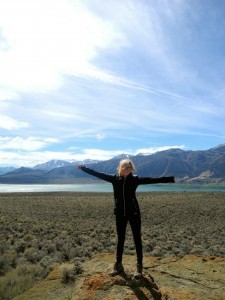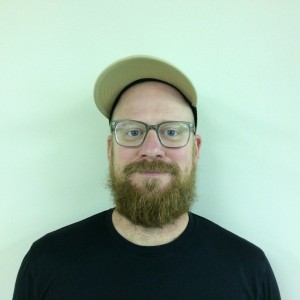Jake Beam
Jake is a postdoctoral researcher at Bigelow Laboratory for Ocean Sciences in East Boothbay, Maine. If he had to classify himself by a specific scientific discipline, he would consider himself a geobiologist. Jake’s primary research focus is biological cycling of iron in marine sediments, but has been known to be easily excited about anything and everything. He has never been to sea, and is very excited to be given this wonderful opportunity. He is also looking forward to hearing and learning from everyone aboard the Sikuliaq, and would like to collect some sediment samples to look for microbes that eat iron and make rust.
Amanda Blackburn
Amanda is a M.S. student in Geologic Oceanography at the University of Alaska Fairbanks College of Fisheries and Ocean Sciences. She received her B.S. from the State University of New York at Potsdam where she double majored in geology and biology with a concentration in marine biology.
Jennifer Brizzolara
Jenn is currently finishing up a Master of Science in Geological Oceanography at the University of South Florida College of Marine Science in Saint Petersburg, FL. Her current work utilizes various types of multibeam sonar data. Multibeam sonar utilizes the time it takes for sound to reflect off the seafloor to determine depth and can be used to create continuous maps of seafloor bathymetry. The backscatter intensity of the returning sound can also indicate seafloor type. Jenn’s thesis work focuses on utilizing towed underwater video to help interpret seafloor types from existing bathymetry and backscatter intensity maps from multibeam sonar data. She is also working as a Research Assistant on the Continental Shelf Characterization, Assessment, and Mapping Project (CSCAMP) planning, collecting, and processing new ultra-high resolution multibeam sonar surveys on the West Florida Shelf. More information about the CSCAMP project can be found here: http://www.marine.usf.edu/scamp/
Kristin Brown
Kristin is in the final year of her M.S. Fisheries degree at the University of Alaska Fairbanks, College of Fisheries and Ocean Sciences-Juneau campus. Her thesis examines sea otter diet and the fate of heavy metals throughout sea otter body tissues. Kristin’s research takes place just outside of Glacier Bay National Park, an area considered to be pristine, and carrying a population of sea otters that has been rapidly increasing since their successful reintroduction to the area between 1965 and 1972 by the Alaska Department of Fish & Game. The study is unique in that it utilizes samples collected from sea otters hunted by an Alaska Native, whereas most sea otter research must utilize stranded carcasses owing to the protection of sea otters by the Marine Mammal Protection Act. The overall goals of the study are to (1) examine sea otter diet composition via stomach contents analysis; and (2) obtain heavy metals concentrations of a robust population of sea otters as baseline data which can then be compared to data collected from declining sea otter populations.
Mary Dzaugis
Mary received her Ph.D. at the Graduate School of Oceanography, University of Rhode Island. Her PhD research focused on the production of H2 through water radiolysis, which has implications for subseafloor life and habitability of Mars. For ten summers she worked as a paleontologist assistant studying 555 million-year old Ediacaran fossils in South Australia. She also has participated on several research cruises looking at biogeochemical properties of seawater and sediment. Mary is excited to participate in the Chief Scientist cruise to learn more about organizing successful interdisciplinary research.
Lauren Frisch
Lauren is the Public Information Officer for the University of Alaska Fairbanks College of Fisheries and Ocean Sciences, and the Science Liaison for the R/V Sikuliaq. As the Science Liaison, she works with scientists who are planning research cruises on the Sikuliaq. She is excited to learn about the cruise planning process, and get to know the different kinds of science instruments that researchers can use on a ship like the Sikuliaq.
Megan Fung
Megan is currently a Ph.D. student at Rensselaer Polytechnic Institute (RPI) in Troy, NY. The geologic record allows for the unique opportunity to evaluate and reconstruct past climate states, providing insights into current and future climate variability. As a micropaleontologist and paleoclimatologist, she utilizes the fossil record (benthic and planktonic foraminifera, ostracods, stable isotopes) to help understand the response of biota to changes in their surroundings (e.g., paleowater depth, temperature, ice volume, carbon reservoir) through the application of geochemistry and assemblage changes reflected in these microorganisms.
Melania Guerra
Melania is a Research Associate at University of Washington’s Applied Physics Lab in the department of Ocean Acoustics and holds a Ph.D in Oceanography from the Scripps Institution of Oceanography. Her research focuses on developing spatial and temporal metrics that quantify underwater ambient noise and characterize its source mechanisms, in order to estimate the contribution of anthropogenic sources to the ocean noise budget. Given concerns for the potential impacts of increased underwater noise levels on marine species, her current projects aim at evaluating changes in the acoustic environment of the Pacific Arctic, with a final objective of informing better decision making in the monitoring and mitigation of industrial activities.
Timothy Hodson
Tim is in the final year of his PhD at Northern Illinois University. His dissertation uses in-situ oceanographic observations along with sediment cores to study processes at glacial grounding zones, particularly how sediments in these environments record information about the dominant processes affecting ice sheet mass balance.
Thomas Kelly
Tom studies the cycling of carbon between the surface layers of the ocean, where photosynthesis takes place, and the deeper ocean waters. To do this he integrates a wide array of measurements including field work, laboratory data and theoretical considerations into a common framework. Additionally Tom works on a range of projects that incorporate computational methods to solve interdisciplinary problems.
Joseph Niehaus
Joe is an atmospheric scientist aboard the Sikuliaq. His specialty is cloud microphysics. Although the clouds are about two miles above us, they form on particles lofted from the surface of the ocean. From our lab at Texas A&M University, he measures those particles.
Megan Roberts
Megan is an Environmental Chemistry PhD student at the University of Alaska Fairbanks. Her current research involves looking into the reactivity, input, and temporal/spatial variability of suspended particulate iron over the Gulf of Alaska shelf. This will be her first experience at sea, and she is hoping this opportunity will help to further develop her scientific communication skills, allow her to be exposed to another area of science, and effectively conduct scientific research with an interdisciplinary team.
Cameron Schwalbach
Cameron is currently working on his M.S. at the University of Cincinnati, focusing on the stratigraphy and paleoecology of Richmondian strata within the Cincinnati Arch region. His primary scientific interests lie within the broad fields of paleontology and stratigraphy, with focus on the ecology and biology of fossil organisms and their relationship with sequence and event stratigraphy. While aboard the R/V Sikuliaq, he hopes to improve his understanding of modern geochemical signatures within both water and sediment, particularly near the sediment-water interface in areas of firm- and hard-ground pavements, in order to shed light on the mechanisms behind the formation of such surfaces during the early Paleozoic.
Monica Schwehr
Monica is a postdoctoral researcher at the Monterey Bay Aquarium Research Institute. She works with sonar- and lidar-based bathymetry data collected from autonomous and remotely operated vehicles.
Ben Urann
Ben is a second year graduate student in the WHOI/MIT Joint Program in Woods Hole, MA. His work focuses on understanding the Fluorine and Chlorine budget of the mantle, as well as the accretion of oceanic crust at slow spreading ridges. He applied to this cruise to better understand the fundamentals of funding and operating cruises, and to network with other young scientists.
Nick Voss
Nick is a PhD student at the University of South Florida in the School of Geosciences. There he studies geodesy with applications to tectonics and natural hazards. Using GPS, he is exploring the relationship between slow-slip earthquakes (earthquakes that take place on timescales from weeks to years) and the earthquake cycle through observation and numerical modeling.
Christina Wertman
Christina is a Ph.D. candidate at the University of Rhode Island Graduate School of Oceanography. She studies coastal oceanography with a particular interest in short-term processes like the effect of storms generating waves as well as longer term processes like the development of coastal currents along the inner continental shelf. She enjoys field work and is excited to participate in more deep water exploration on the R/V Sikuliaq. She hopes to gain experience learning different measuring techniques, as well as develop better communication skills on this Chief Scientist Training Cruise.
Lauren (Niki) Watson
Nikki graduated from San Francisco State University with a B.S. in Geology. She is currently taking part in various research opportunities to get experience and determine a focus for a future Ph.D. This program will help her gain knowledge on writing proposals, research tools used on the ship, and how to execute a successful research cruise.
Anastasia Yanchilina
Anastasia is a postdoctoral fellow at the Weizmann Institute of Science studying the diagenesis of biogenic silica (diatoms and radiolarians) into chert and application of stable isotopes to obtain past ocean temperature millions of years ago. During the Chief Scientist Training Program on the R/V Sikuliaq, she hopes to use tools on board (i.e. multibeam echo sounder, sub-bottom profiler) to look at changes across faults and beneath the sea floor between Honolulu and San Diego and to diagnose if any changes can be used to explain and understand recent seismic activity. Anastasia will also use this opportunity to work with other early career participants to design an expedition plan and carry it out with the instruments available on board the ship.
Subbarao Yelisetti
Subbarao is an Assistant Professor of Geophysics at Texas A&M University-Kingsville. His research interests involve plate tectonics and geophysical structure at continental margins. Using various types of geophysical data, his research examines crustal-scale structures of the margins, which provide important control on understanding natural hazards such as earthquakes and tsunamis. His research also focuses on the detailed sediment structure in basins and in the accretionary sediment wedge at subduction zones, particularly the frozen methane gas hydrate layer which is found within a few hundred meters of the seafloor and represents a potential massive energy resource and contributor to global climate change. During this cruise, he would like to learn more about NSF proposal writing strategies, and collect various geophysical data to study seamounts and methane seeps.
John Zayac
John is a PhD student in the Earth and Environmental Sciences Program at The Graduate Center of the City University of New York (CUNY). His research applies field-based and analytical methods to study the eruption trigger mechanisms and mechanics of large, explosive, compositionally-zoned eruptions of Volcán Cosigüina, Nicaragua. John joined this cruise in order to expand his field research toolkit beyond the subaerial, and to become familiar with the nuts and bolts of submarine science.


